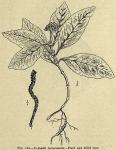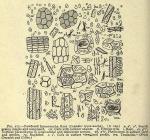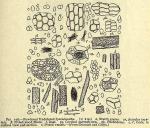 The dried root, of Cephae'lis Ipecacuan'ha (Brotero) A. Richard (Fam. Rubiaceae), known commercially as Rio Ipecac, C. acuminata Karsten, known commercially as Cartagena Ipecac. The value is dependent upon the percentage of alkaloidal constituents, should yield not less than 1.75 per cent. of ether soluble alkaloids of Ipecac, U.S.P.
The dried root, of Cephae'lis Ipecacuan'ha (Brotero) A. Richard (Fam. Rubiaceae), known commercially as Rio Ipecac, C. acuminata Karsten, known commercially as Cartagena Ipecac. The value is dependent upon the percentage of alkaloidal constituents, should yield not less than 1.75 per cent. of ether soluble alkaloids of Ipecac, U.S.P.
Two important alkaloids (emetine and cephaëline) are present in ipecac; the proportion in which these exist seems to vary, and this variation seems to depend upon the accidents of growth and the surroundings of the individual plant.—See Constituents.
 BOTANICAL CHARACTERISTICS.—The root perennial, knotty, with transverse rings; stems suffruticose, ascending, somewhat pubescent toward the apex. Leaves opposite, oblong, roughish above, finely pubescent beneath. Inflorescence capitate, inclosed by a large one-leafed involucre; flowers bracteate; corolla white, funnel-form, the limb with reflexed segments; stamens 5, slightly exserted. Fruit a dark violet berry, crowned by the limb of the calyx, 2-celled, 2-seeded.
BOTANICAL CHARACTERISTICS.—The root perennial, knotty, with transverse rings; stems suffruticose, ascending, somewhat pubescent toward the apex. Leaves opposite, oblong, roughish above, finely pubescent beneath. Inflorescence capitate, inclosed by a large one-leafed involucre; flowers bracteate; corolla white, funnel-form, the limb with reflexed segments; stamens 5, slightly exserted. Fruit a dark violet berry, crowned by the limb of the calyx, 2-celled, 2-seeded.
SOURCE AND VARIETIES.—Grows in the damp woods of the Brazilian valleys, notably in the provinces of Para, Rio Janeiro, Pernambuco, etc. This variety is known in commerce as Rio ipecac, while that from Colombia is called Carthagena ipecac. The former is usually preferred, but the latter is now more common. The plant Psychotria medica is sometimes termed and sold as Carthagena ipecac, but it is devoid of alkaloid. The Brazilian plant is quite hardy, appearing as a creeping vine or bush. The roots usually grow thicker as they penetrate the ground and then taper off again to a point or thin rootlet. Collectors usually leave a part of every other plant in the ground, so that in about three years another crop may be harvested. "Wiry root," consisting of about 75 per cent. of woody portion and 25 per cent. cortex, is, according to Dohme, richest in alkaloids. It has a rather rough, uneven appearance, and is popularly less esteemed than the so-called "fancy" root consisting of 75 per cent. cortex. This prejudice, according to Dohme, is difficult to overcome.
DESCRIPTION OF DRUG.—Rio Ipecac.—In pieces of irregular length, rarely exceeding 25 cm.; stem portion 2 to 3 mm. thick, light gray-brown, cylindrical and smoothish; root portion usually red-brown, occasionally blackish-brown, rarely gray-brown, 3 to 6 mm. thick, curved and sharply tortuous, nearly free from rootlets, occasionally branched, closely annulated with thickened, incomplete rings, and usually exhibiting transverse fissures with vertical sides, through the bark; fracture short, the very thick, easily separable bark whitish, usually resinous, the thin, tough wood yellowish-white, without vessels; odor very slight, peculiar, the dust sternutatory; taste bitter and nauseous, somewhat acrid. It is stated by Rusby that the Rio variety has almost ceased to arrive in the market, the Carthagena variety being supplied. This is now mostly what is known as Panama Ipecac.
Carthagena ipecac is of a dull gray color, thicker, less frequently and sharply crooked, and lacks the constrictions characteristic of Rio ipecac, although it bears the annular thickenings, or merging annulae. The thick bark, on cross-section, has rather a grayish color, the medullary rays are more prominent and more numerous.
STRUCTURE.—The thin outer layer of cork cells contains a brownish-red deposit, thought by some to be emetine in combination with ipecacuanhic acid. The thick inner cortical layer consists of starchy parenchyma, free from medullary rays, but containing a circle of stone cells filled with calcium oxalate crystals. Transverse sections show rather a small layer of cork cells, a thick cortical portion consisting of parenchyma, loaded with starch and rich in alkaloid. The woody portion, radiate, contains little or no alkaloid.

 Powder.—Characteristic elements; See Part iv, Chap. I, B.
Powder.—Characteristic elements; See Part iv, Chap. I, B.
CONSTITUENTS.—Emetine (1 to 2 per cent.), cephaëline, psychotrine, and a peculiar tannic acid called ipecacuanhic or cephaëlic acid, starch, resin, etc. The active principles exist only in the bark of the root, and probably in the thin, outer layer of cork cells. Recently considerable light has been thrown on emetine, C15H22N2O5. and cephaëline, C14H20NO2, which were formerly supposed to be one body. According to Paul and Cownley ("Pharm. Jour.," 1896) cephaëline is the emetic principle and emetine the expectorant principle of the drug. This naming is unfortunate, and should be reversed. Emetine is amorphous; cephaëline crystalline. Ash, not less than 1.8 per cent. nor more than 4.5 per cent.
KRYPTONINE.—This is the name of a new alkaloid of ipecac, discovered by J. U. Lloyd. The principle itself, as well as its acid compounds, are colloidal in character. It belongs apparently to a new group of principles awaiting further investigation. Filter paper shows a marked adsorptive property to this alkaloid. It is black in mass but of varying color in different solvents. See Proc. Amer. Ph. Asso., 1916. Condensed description Amer. Druggist, Oct., 1916, P. 28.
Preparation of Emetine.—A very simple process is to exhaust the drug with boiling chloroform made slightly alkaline with solution of ammonia. Upon distilling off the chloroform the emetine is left in a very pure condition, and, when dried at 100°C., gives a residue which, when weighed, gives one a rough estimate of the value of the drug. Cephaëline is extracted usually with emetine in most of the processes for assay. It is less soluble in ether than emetine.
Preparation of Ipecacuanhic Acid (Cephaëlic Acid).—Precipitate decoction with lead acetate, dissolve precipitate with acetic acid, and precipitate solution with lead subacetate; wash and dry. Resembles caffeotannic acid.
ACTION AND USES.—When locally applied, acts as counter-irritant. Small doses are diaphoretic and expectorant. In large doses a systemic emetic, in minute doses stomachic, aiding digestion. Ipecac has been used, since its introduction into medicine, as a remedy in dysentery, when there is said to be a peculiar tolerance of the drug, but the fact is the stomach almost invariably rejects large doses. Recent experiments prove that ipecac, when deprived of its emetine, possesses its full antidysenteric properties, without the drawbacks of depression, nausea, etc. Accordingly there appears in the market to meet this peculiar demand a preparation made from de-emetinized bark. Emetine has recently been highly praised in the treatment of pyorrhea, Riggs' disease. Hypodermic tablets of the hydrochloride, containing from 0.016 to 0.032 Gm. are prepared. Used in the form of injections in diseases due to pathogenic amebas. Also administered internally, "Alcresta Ipecac" when thus administered is decomposed in the alkaline fluid of the intestines with liberation of alkaloids and produce amebacidal action. Tablets of same, representing 10 gr. of ipecac are dispensed. Dose 2 or 3 tablets three times a day at first period of few days, then discontinued for a day or two, if laxative effect is produced. Dose of ipecac as expectorant, 1 gr. (0.06 Gm.); emetic, 10 to 15 gr. (0.6 to 1 Gm.).
- OFFICIAL PREPARATIONS.
- Fluidextractum Ipecacuanhae Dose: 3 to 8 drops (0.2 to 0.,5 mil);
- 15 to 60 drops (1 to 4 mil) .
- Syrupus Ipecacuanhae (7 per cent.),
- Adult exp. 30 drops (2 mils),
- Emetic 6 fl. dr. (24 mils).
- Pulvis Ipecacuanhae et Opii (10 per cent. of each) 5 to 15 gr. (0.3 to 1 Gm.).

